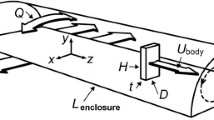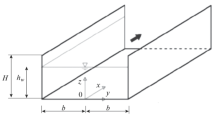Abstract
A relatively simple method of calculating the parameters of the flow behind a blunt trailing edge separating two supersonic streams is developed. The method is based on the use of the boundary layer approximation and integral laws of mass and energy conservation (viscous-inviscid interaction model). It makes it possible to determine the base pressure and base enthalpy with allowance for the effect of Mach numbers, Reynolds numbers, initial boundary layer thicknesses, specific heat ratios and wall enthalpies for various ratios of the total pressures and enthalpies of the two streams.
Similar content being viewed by others
Literature cited
H. H. Korst and W. Tripp, “The pressure on a blunt trailing edge separating two supersonic two-dimensional air streams of different Mach number and stagnation pressure but identical stagnation temperature,” Proc. Fifth Midwest Conf. Fluid Mech. Univ. Michigan, April 1–2 (1957), p. 187.
M. A. Beheim, J. L. Klann, and R. A. Yeager, “Jet effects on annular base pressure and temperature in a supersonic stream,” NASA Techn. Rep., NR-125, 40 (1962).
K. E. Yurchenok, “Base pressure and temperature behind axisymmetric bodies with interaction between a jet and the supersonic stream,” Izv. Akad. Nauk SSSR, Mekh. Zhidk. Gaza, No. 2, 80 (1974).
J. Agreil and R. A. White, “An experimental investigation of supersonic axisymmetric flow over boattails containing a centered propulsive jet,” FFA — TN — AU — 913, Stockholm (1974).
N. Wagner and R. A. White, “Supersonic base flow problem in the presence of an exhaust jet,” AIAA J.,18, 876 (1980).
G. S. Deiwert, “Supersonic axisymmetric flow over boattails containing a centered propulsive jet,” AIAA J.,22, 1358 (1984).
J. Sahn, “Computations of supersonic flow over a missile afterbody containing an exhaust jet,” J. Spacecr. Rockets,24, 403 (1987).
R. K. Tagirov, “Effect of initial boundary layer on base pressure,” Izv. Akad. Nauk SSSR, Mekh. Zhidk. Gaza, No. 2, 145 (1966).
R. K. Tagirov, “Calculation of the base pressure and the parameters of the separated flow behind a flat blunt trailing edge at sonic or supersonic free-stream velocities,” Tr. TsIAM, No. 538, 14 (1972).
J. B. Miles and J.-S. Shih, “Similarity parameter for two-stream turbulent jet-mixing region,” AIAA J.,6, 1429 (1968).
F. H. Clauser, “The turbulent boundary layer,” in: Problems of Mechanics, Vol. 2 [in Russian], Izd. Inostr. Lit., Moscow (1959), p. 297.
P. A. Sokolov, “Correction to the Chapman-Korst criterion as a result of the action of viscous forces in a flow reattachment zone,” Tr. TsAGI, No. 1808, 23 (1977).
D. A. Chapman, D. M. Kuehn, and H. K. Larson, “Investigation of separated flows in supersonic and subsonic streams with emphasis on the effect of transition,” NASA Rep., No. 1356, 40 (1958).
L. V. Gogish and G. Yu. Stepanov, Turbulent Separated Flows [in Russian], Nauka, Moscow (1979).
R. K. Tagirov, “Calculation of the critical pressure drop at a shock associated with separation of the turbulent boundary layer,” Izv. Akad. Nauk SSSR, Mekh. Zhidk. Gaza, No. 4, 38 (1985).
S. N. Bogdanoff, “A preliminary study of Reynolds number effects on base pressure at M = 2.95,” J. Aeronaut. Sci.,19, 201 (1952).
H. H. Korst, “A theory for base pressures in transonic and supersonic flow,” J. Appl. Mech.,23, 593 (1956).
R. H. Page and H. H. Korst, “Nonisoenergetic turbulent compressible jet mixing with consideration of its influence on the base pressure problem,” Proc. Fourth Midwest. Conf. on Fluid Mechanics, Sept., 1955, Research Ser. No. 128 (1956), p. 45.
M. K. Aukin and R. K. Tagirov, “Second-order finite-difference scheme for calculating three-dimensional inviscid supersonic gas flows,” Zh. Vychisl. Mat. Mat. Fiz.,29, 1057 (1989).
Author information
Authors and Affiliations
Additional information
Translated from Izvestiya Akademii Nauk SSSR, Mekhanika Zhidkosti i Gaza, No. 5, pp. 167–176, September–October, 1991.
Rights and permissions
About this article
Cite this article
Masalov, V.K., Tagirov, R.K. Calculation of base pressure and enthalpy behind a blunt trailing edge separating two supersonic streams with allowance for boundary layers and heat fluxes. Fluid Dyn 26, 776–784 (1991). https://doi.org/10.1007/BF01051001
Received:
Issue Date:
DOI: https://doi.org/10.1007/BF01051001




